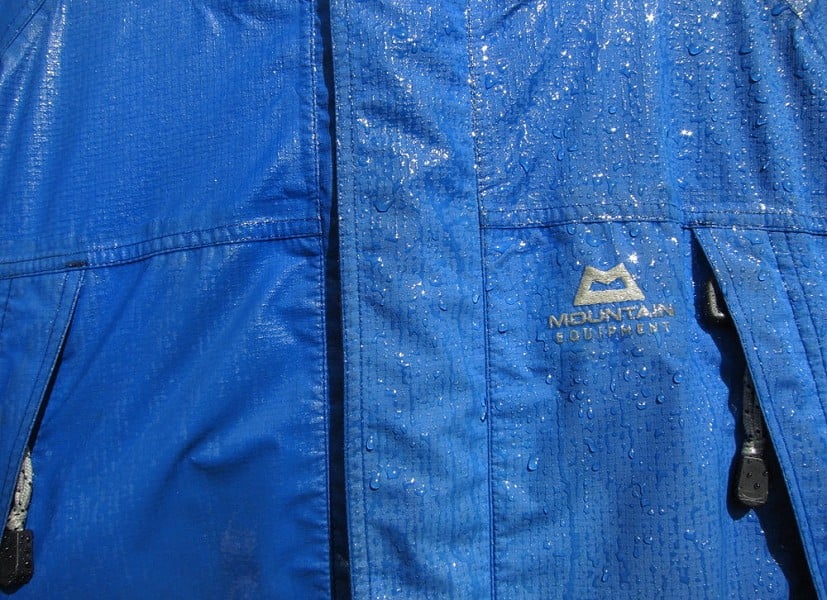Caring for Your Waterproof
After reading all the reviews on UKH/UKC, and trying on several models, you've finally invested in a new waterproof jacket. Job done? Not so fast. Unfortunately it won't stay in brand new state for long, without a bit of help. Sweat, dirt and general grime will soon begin to compromise its performance, so to keep your shell working at its best you'll need to go through the ritual of regular washing and reproofing. Time spent doing this is worth the effort, since keeping it clean and well proofed should extend the effective life of the jacket, not only saving money in the long run, but helping to reduce your environmental impact.
When it comes to being more sustainable, looking after our gear is one of the simplest yet most effective measures we can take. Let's face it, most of us could probably do with buying less stuff, and keeping it going for longer. It doesn't get much more basic than washing and reproofing.
Caring for your shell has become more of a consideration recently, as manufacturers move away from the environmentally damaging PFCs formerly used in the Durable Water Repellent (DWR) finish of most waterproof clothing, to less harmful but also less long-lasting alternatives. While the development of new fabric technology is an essential step towards a more sustainable outdoor industry, the inconvenient truth is that PFCs are highly effective and durable when used as a water-repellent treatment, and their replacements do not - as yet - match up. Future research may close the gap.
Without such an effective and long-lasting DWR, the current crop of PFC-free fabrics are prone sooner to 'wetting out', absorbing moisture rather than simply beading it off. Once the face fabric is saturated, the membrane inside can't do such a good job of transporting water vapour out of the shell, so the garment effectively becomes less breathable, and the wearer correspondingly more clammy. Dirt and grease can exacerbate this process.
If you've bought a PFC-free shell then you're doing the planet a favour - but you'll definitely need to pay attention to keeping it clean, and occasionally refreshing the treatment by topping it up with an appropriate product. For generations accustomed to waterproofs that keep on shedding the rain year in, year out, perhaps with only minimal attention, a slight shift in expectation may now be on the cards. Luckily it's not a huge effort.
We examined the technical nitty gritty of this development in the first part of our Sustainable Gear series:
Now let's look more closely at the washing and reproofing process itself:
How to wash your shell
It used to be possible to launder your waterproof clothing once in a blue moon, and simply expect the DWR to go on working well; but with the latest generation of PFC-free shells washing is now something to consider doing after every couple of uses - much as you would your smelly baselayer. This really is the only way to ensure the PFC-free DWR will continue to perform as designed.
- Note that washing detergent and fabric softener can mask the DWR of your shell, and will clog the pores of the membrane. Never use these standard laundry products to clean waterproof clothing. Before starting, ensure that the detergent drawer of your washing machine is free of residue - most trays are removable for easy rinsing.
- Close all the zips.
- If there are any particularly dirty areas - caked mud for instance - try to wash the worst of it off under a tap, before sticking your shell in the washing machine.
- Add a dedicated technical liquid cleaning product to the detergent drawer, such as Nikwax Tech Wash, following the quantity instructions on the bottle.
- Remember: don't use additional fabric softener.
- Wash your shell according to the garment's care instructions - for most shells that'll be a 40 degree wash at most (but do check!)
- If you're not going to reproof too, then you're done. If the care label allows, it's possible to tumble dry your shell; but air drying works fine too, and saves energy.
How to reproof your shell
Periodically refreshing the DWR treatment will maintain the beading effect of your waterproof fabric, and the breathability that depends on it. Do this every few washes; it's not necessary to reproof every time you wash.
- Having first washed the shell as above, keep it in the machine for the second stage in the process.
- Pour a dedicated wash-in reproofer such as Nikwax TX Direct into the detergent tray, according to the quantities on the bottle.
- Run a cool wash at 30 degrees, on a slow speed setting.
- Hang it up to dry...
What's the impact of all that washing and treating?
While the elimination of PFCs, and their 'forever chemicals' is undeniably an advance in environmental terms, the fact that all PFC-free waterproof clothing needs to be washed and reproofed more regularly has an impact of its own too, since each wash cycle uses electricity and water, and leads to waste products. To keep that footprint as small as possible wash several garments at the same time instead of individually; and ensure that you're using the most sustainable products available - Nikwax are genuinely the gold standard here.





